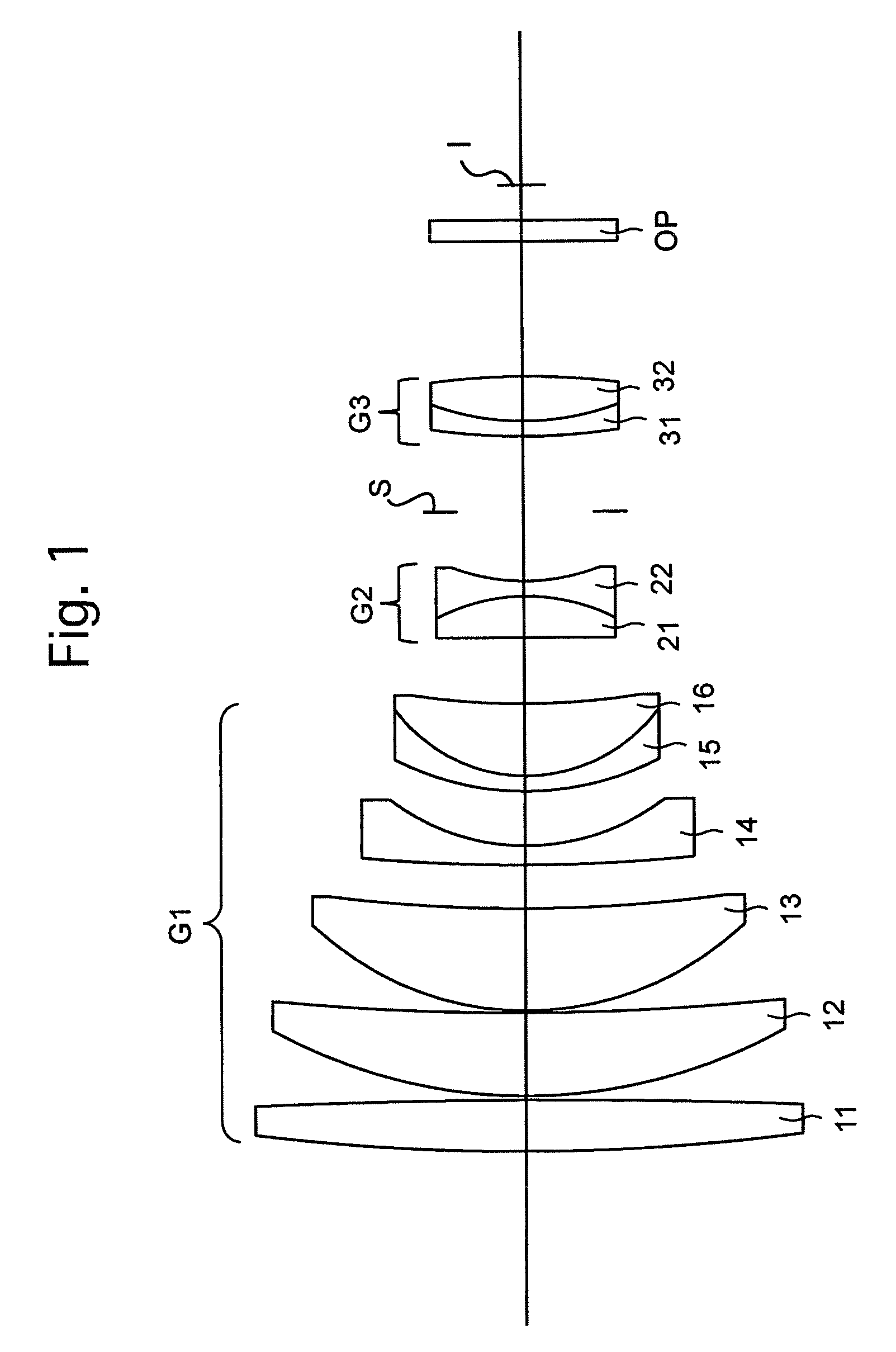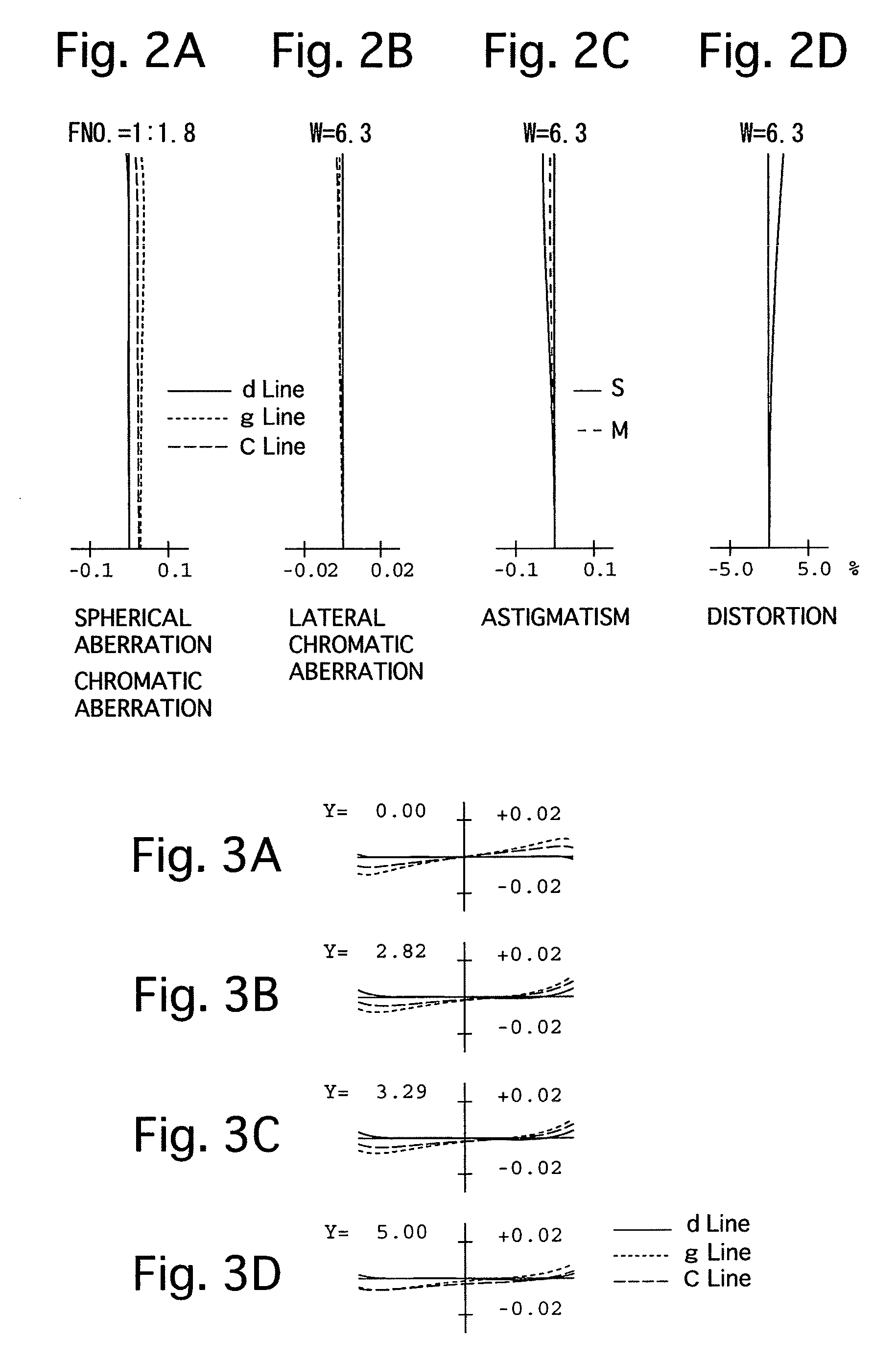Large-aperture telephoto lens system
a telephoto lens and large aperture technology, applied in the field of large aperture telephoto lens systems, can solve the problems of difficult to achieve a high imaging quality, the effective diameter of the focusing lens group is too large for use, and the autofocus drive mechanism is burdened, so as to reduce the weight of the focusing lens group, reduce the burden, and achieve superior optical quality
- Summary
- Abstract
- Description
- Claims
- Application Information
AI Technical Summary
Benefits of technology
Problems solved by technology
Method used
Image
Examples
numerical embodiment 1
[0078]FIGS. 1 through 3D and Tables 1 and 2 show a first numerical embodiment of a large-aperture telephoto lens system according to the present invention. FIG. 1 shows a lens arrangement of the large-aperture telephoto lens system when focusing on an object at infinity. FIGS. 2A, 2B, 2C and 2D show various aberrations that occurred in the lens arrangement shown in FIG. 1. FIGS. 3A, 3B, 3C and 3D show various lateral aberrations that occurred in the lens arrangement shown in FIG. 1. Table 1 shows lens surface data, and Table 2 shows various data of the large-aperture telephoto lens system.
[0079]The large-aperture telephoto lens system according to the first numerical embodiment is configured of a positive first lens group G1, a negative second lens group G2, and a positive third lens group G3, in that order from the object side. A diaphragm S is provided between the second lens group G2 and the third lens group G3. An optical filter OP is provided in between the third lens group G3 ...
numerical embodiment 2
[0085]FIGS. 4 through 6D and Tables 3 and 4 show a second numerical embodiment of a large-aperture telephoto lens system according to the present invention. FIG. 4 shows a lens arrangement of the large-aperture telephoto lens system when focusing on an object at infinity. FIGS. 5A, 5B, 5C and 5D show various aberrations that occurred in the lens arrangement shown in FIG. 4. FIGS. 6A, 6B, 6C and 6D show various lateral aberrations that occurred in the lens arrangement shown in FIG. 4. Table 3 shows lens surface data, and Table 4 shows various data of the large-aperture telephoto lens system.
[0086]The lens arrangement of the second numerical embodiment is the same as that of the first numerical embodiment except for the following (1):
[0087](1) The negative lens element 31 of the third lens group G3 is a biconcave negative lens element.
[0088]
TABLE 3SURFACE DATASurf. No.RdN(d)ν(d) 175.2112.9731.4874970.4 2−1236.4400.200 332.9133.7781.4970081.6 4136.6560.100 517.0535.3491.4970081.6 688.7...
numerical embodiment 3
[0090]FIGS. 7 through 9D and Tables 5 and 6 show a third numerical embodiment of a large-aperture telephoto lens system according to the present invention. FIG. 7 shows a lens arrangement of the large-aperture telephoto lens system when focusing on an object at infinity. FIGS. 8A, 8B, 8C and 8D show various aberrations that occurred in the lens arrangement shown in FIG. 7. FIGS. 9A, 9B, 9C and 9D show various lateral aberrations that occurred in the lens arrangement shown in FIG. 7. Table 5 shows lens surface data, and Table 6 shows various data of the large-aperture telephoto lens system.
[0091]The lens arrangement of the third numerical embodiment is the same as that of the first numerical embodiment except for the following (1), (2) and (3):
[0092](1) The negative lens element 14 of the first lens group G1 is a biconcave negative lens element.
[0093](2) The positive lens element 16 of the first lens group G1 is a biconvex positive lens element.
[0094](3) The positive lens element 21 ...
PUM
 Login to View More
Login to View More Abstract
Description
Claims
Application Information
 Login to View More
Login to View More - Generate Ideas
- Intellectual Property
- Life Sciences
- Materials
- Tech Scout
- Unparalleled Data Quality
- Higher Quality Content
- 60% Fewer Hallucinations
Browse by: Latest US Patents, China's latest patents, Technical Efficacy Thesaurus, Application Domain, Technology Topic, Popular Technical Reports.
© 2025 PatSnap. All rights reserved.Legal|Privacy policy|Modern Slavery Act Transparency Statement|Sitemap|About US| Contact US: help@patsnap.com



